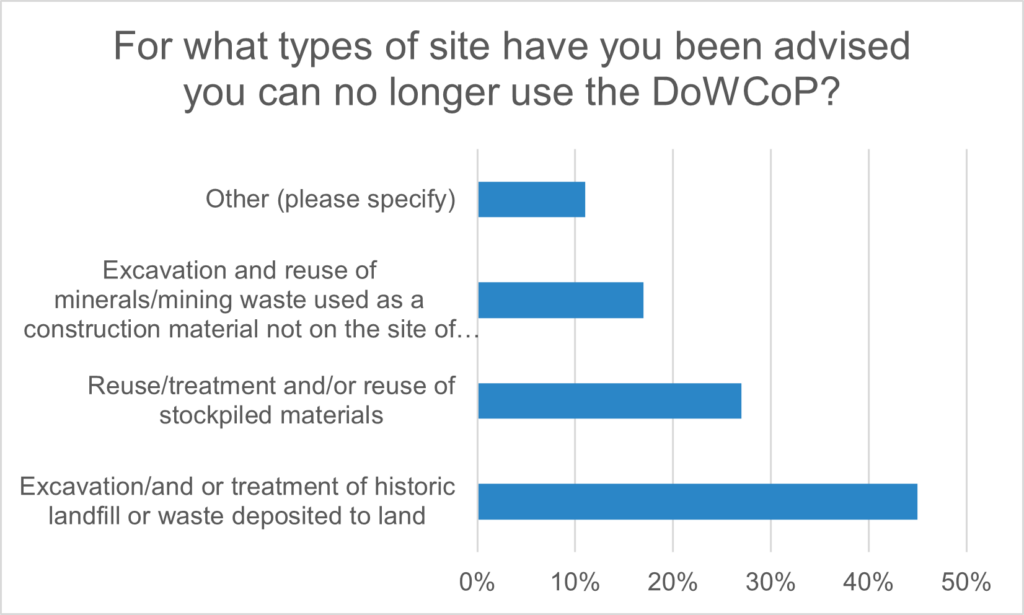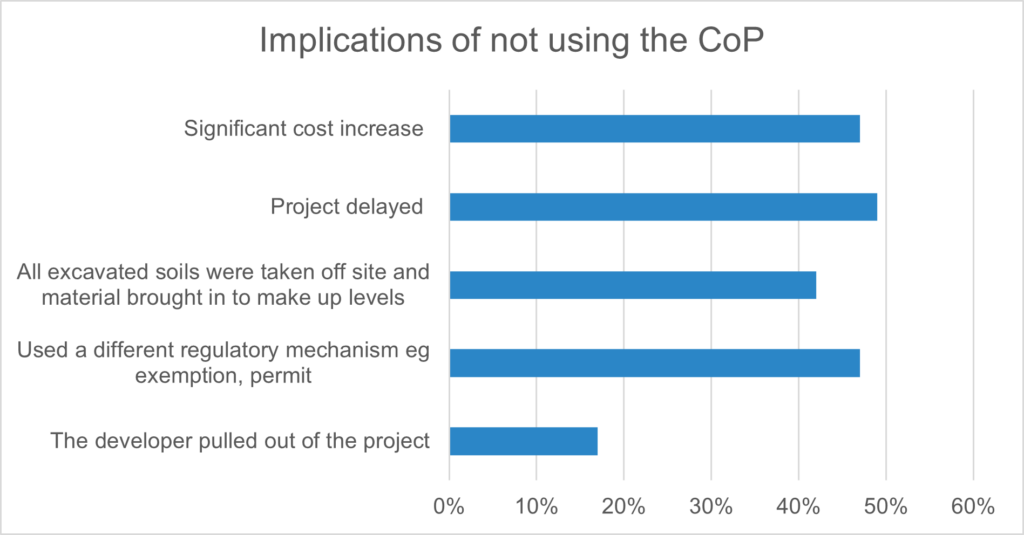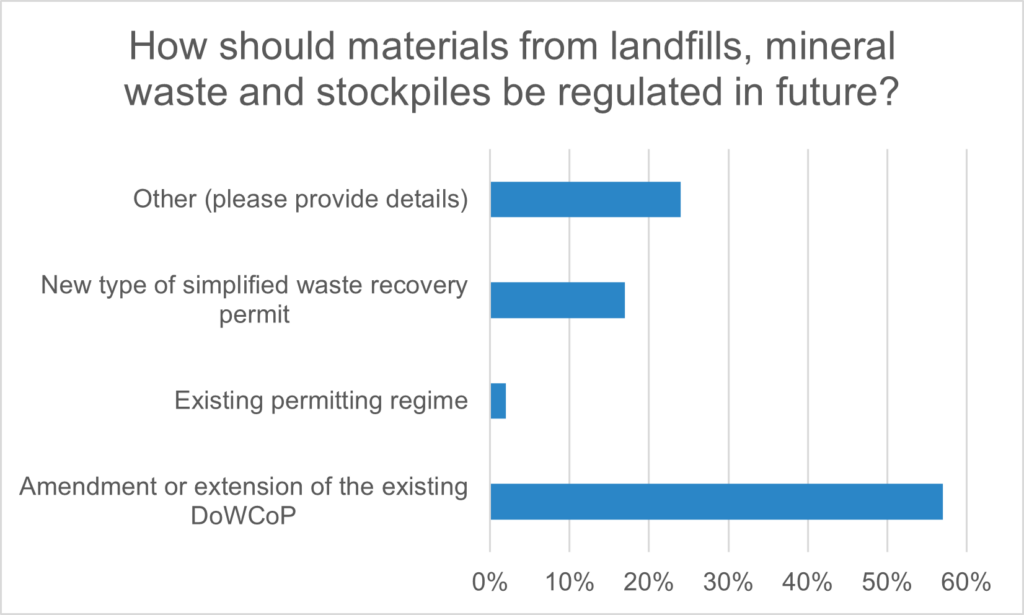Given on-going interest and concerns about regulatory constraints to the regeneration of former landfill sites, Specialist in Land Condition (SiLC) has been examining recent regulatory approaches and use of the CL:AIRE Definition of Waste Code of Practice (DoWCoP) in England and Wales.
SiLC held a webinar in June 2022 entitled ‘Regeneration of historical landfill sites – views from multistakeholder perspectives’. This included looking at the history and development of the DoWCoP and the key decisions that underpinned this; presentation of case studies which illustrated how DoWCoP could effectively be used for regeneration of historical landfills while securing environmental betterment and protection of health; and case studies that clearly showed significant concerns with undertaking land regeneration under the permitting regime. Alongside this webinar, SiLC undertook an online survey in August and September 2022 requesting views on the use (and misuse) of the DoWCoP and experiences of the difference between project and programme delivery via DoWCoP and waste recovery permitting. There was a large response to this with some 212 responses received from the consulting, contracting and regulatory brownfield development community. The key take-away messages included a strong desire to maintain the DoWCoP as a robust and effective tool to manage brownfield development (including historical landfills) but also highlighted some issues. For example, the survey responses referred to inappropriate use of the DoWCoP for dealing with mineral wastes, such as colliery spoil.
The DoWCoP was published in 2008 and is currently in its 2nd edition, with a 3rd edition keenly awaited for some time. On 12th July 2021 the Environment Agency (EA) confirmed to SiLC that “Our DoW CoP and Land Contamination leads are in the final stages of drafting internal guidance around these matters as we are aware of the industry’s interest. The guidance will make it clear to our staff the appropriate permitting options for these activities and ensure we maintain consistency in our opinion. We will share this with you once it has been issued and welcome any further comments.” SiLC wrote to DEFRA and the EA on 21st April 2023 again requesting a review of EA guidance Downloads | Specialist in Land Condition Register Ltd (SiLC)
The current scope of the DoWCoP covers the reuse of soil, rock, dredged material, made ground and aggregates derived from construction and demolition waste as well as stockpiles containing these materials on the site of origin. The 2nd edition expanded the scope of the DoWCoP to include transferring natural soils and rock directly from a donor site to a development. It is however important to note that the DoWCoP specifically excludes application to soil contaminated with invasive weeds, infrastructure (pipes, tanks), construction wastes such as plasterboard, glass and wood, and mining wastes. Whilst not specifically excluding historical landfills from the DoWCoP, it is becoming increasingly the case that the Environment Agency will not support the use of the DoWCoP for any development work on such a site regardless of its licensing/ permitting history and date of deposition.
Table 1
| Percentage of respondents who have used DoWCoP for material reuse on: | ||
| Historic landfills | Old stockpiles | Mineral waste or colliery spoil |
| 39% (82 respondents) | 65% (137 respondents) | 24% (50 respondents) |
The figures in Table 1 demonstrate a lack of understanding and confusion within the industry of what the DoWCoP covers and points towards confusion within the regulatory bodies who must confirm no objections (or no response within 21 days) to the reuse of materials in advance of a declaration being made. One Local Authority respondent reported “we often have to respond to EA/QP issues (i.e. sites being subject to DoWCoP when planning conditions for site investigation have not been satisfied let alone agreed a Remediation Method Statement”.
Over the last three years half the respondents reported being told by the EA they could no longer use DoWCoP for projects they would previously have done so (Graph 1) with the main reason being cited as development of historical landfills. One respondent indicated that personal discussions with EA Area Officers has clearly shown that Area Officers are also frustrated. They can often see environmental benefits and gains from a proposal that they are told is no longer in line with EA national thinking on the use of DoWCoP. One QP responded “It is not always going to be acceptable to reuse material from a historical landfill, or a stockpile, these are site specific decisions and often, will not be straight forward. Rather than a blanket, include or don’t include in DoWCoP, each case should be considered in terms of its Conceptual Site Model.”
Graph 1
While the position for historical landfills is understood not to have yet been formalised the following footer is now appearing on some emails from the EA permitting team “The Environment Agency considers that any material which consists of current or historically landfilled waste remains waste on excavation and therefore cannot be used under DoWCoP. Excavated landfilled waste materials require appropriate waste controls such as an environmental permit for storage, treatment and deposit.” Whilst this position is now being circulated, there is limited steer or guidance on specifics such as what constitutes a current or historically landfilled waste, which could again be subject to interpretation. In addition, consultants have recently reported changes in position within the EA on how sites are to be regulated mid-way through projects.
30% of respondents had obtained an environmental permit to permanently deposit waste on land as a recovery activity (also referred to as deposit for recovery or DfR for short) in the previous 18 months. The time required to obtain the permit varied with 8% (five) of permits issued in six months or less, average was between 18 months to 2 years, with some reported as five years. Two refusals were reported after 3 years of consultations.
Major benefits of using the DoWCoP compared to a DfR permit are considered to be the reduced time and costs taken to prepare the Material Management Plan and submit the declaration. Where DoWCoP has not been used to support development our survey respondents reported significant cost increases, project delays and worryingly a trend towards the requirement to landfill material off-site and importing virgin aggregates to make up levels (Graph 2). Almost 1 in 5 projects were abandoned because the increased costs and delays to programme. 80% of respondents consider the exclusion of landfills, mining wastes and stockpiles from DoWCoP would hinder brownfield development. Some commonly expressed views were that their exclusion seems arbitrary and would hinder sustainable materials management for no economic, social or environmental benefit. Respondents also acknowledged that there needs to be effective regulatory oversight, particularly with landfilled wastes. Excluding landfills is considered counterproductive to the drive for sustainability and adoption of circular economy principles, leading to superfluous use of virgin materials, which result in the additional use of earth’s resources, increased carbon expenditure from additional transport of materials, impact on the utilisation of key landfill space. Regeneration of landfill sites can have considerable positive impact on the social value of an area and short term potential negative impacts during redevelopment need to be managed.
Graph 2
There is a significant view from respondents that the DoWCoP should be extended to cover development of landfills and materials from former mining activities including old stockpiles (Graph 3). The existing permitting regime has few advocates within the industry with some calls for a simpler (quicker) standard rules waste recovery permit.
Graph 3
There were also calls to modify the definition of waste to exclude materials for which there is a defined use. The review of legislation since Brexit offers an opportunity to rethink how waste is classified and material is reused within the UK in accordance with circular economy, sustainable development and net zero principles.
Conclusions
There is an increasing trend from the EA to require an environmental permit (deposit for recovery) to manage the reuse of material on development sites (historic, current landfills, stockpiles, possible mining extractive waste etc). The EA does not have capacity within the permitting system to accommodate this increase. Permit decision times of greater than 6 months will not work in the construction sector. An increasing number of permits need to be bespoke because material for reuse and/or the environmental setting does not fit the standard rule permits available.
The DoWCoP has proved its worth to the brownfield development industry since its publication in 2008. It offers a simple cost-effective and crucially timely approach to managing the reuse of materials in construction. It also provides a pragmatic approach to the sustainable reuse of materials supporting the drive for circular economy, zero waste and enhancing social value all of which are key concerns in relation to brownfield regeneration. The constraint to regeneration posed by the need to use the permitting regime is at odds with government drivers including brownfield first, recovery from Covid, levelling up and build back better. However, use of the DoWCoP has been inappropriate at times and as an industry we need to tighten up our understanding and application of it to regeneration.
Article provided by Clive Williams (Senior Associate Contaminated Land, Mott MacDonald), Louise Beale (Technical Director, SLR Consulting), Sarah Owen (Senior Associate, Waterman), Sarah Bullock (Associate Director, Atkins) and Catherine Copping (Technical Director, Stantec)


